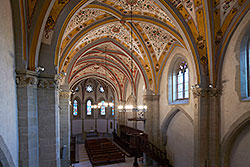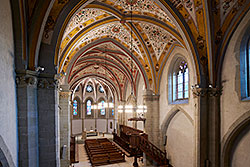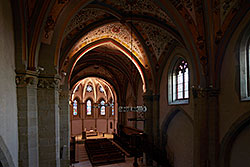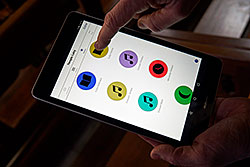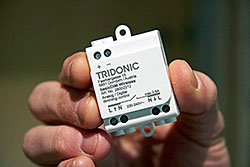Intelligent lighting in historical building
Bluetooth lighting control provides demand-based lighting scenes in the Temple de Lutry
Its beginnings date back to the 11th century and it is a cultural asset of national importance. Therefore, anyone who carries out construction work or technical installations in the Temple de Lutry in the heart of the old town of Lutry has to meet stringent requirements. In the recent upgrade of the lighting to LED technology, the existing wiring had to be used as far as possible. Even so, a modern lighting control system could be implemented thanks to wireless technology from Tridonic.
1000 years of architecture
The Swiss municipality of Lutry on the shores of Lake Geneva is a picturesque little town. Set among vineyards, there is a castle from the 14th century, a promenade with an old port and a listed town centre, inviting tourists to explore. An important landmark is the Temple de Lutry, the reformed parish church of Saint Martin in the centre of the old town. Originally built as a church for a Benedictine priory in the 11th century, it can look back on 1000 years of history. Numerous alterations and extensions have been made over the centuries: the polygonal choir dates back to 1260, the nave was refurbished after a fire in 1344, and the northern side chapels were added in the 14th and 15th centuries.
There were further changes after the Reformation. Today’s tower was built in 1544, and from 1569 to 1578 the Renaissance portal was constructed. Reformation could also have given a decisive impetus to the decorative paintings inspired by Mannerism and Renaissance in the vaults of the nave. It is said that the municipality made a promise to follow the Reformation in return for these works. This is not historically documented, but it has been proven that the paintings date back to the 16th century and were created by artist Humbert Mareschet.
Focus on energy efficiency and intelligent control
Since the autumn of last year, not only the precious paintings but also all the other architecturally interesting details of the church have appeared in all their splendour, because Saint Martin has been equipped with a modern lighting solution. The people in charge at Lutry’s Service de l’aménagement du territoire et bâtiments above all expected significant energy savings and reduced maintenance costs from the upgrade of the existing halogen lighting to LED lighting. In addition, they wanted to have a control system that would make it easier to adjust the lighting to the different uses of the church.
To put these requirements into practice, Senseco, the lighting design office from Lausanne commissioned to carry out the work, had to overcome a difficult challenge, however. “Under no circumstances were we allowed to interfere with the historical structure of the church,” explains Yannick Le Moigne from Senseco. “Laying additional power or data cables was taboo so we solved the problem with a wireless lighting control system.” Each light point is now equipped with a basicDIM Wireless control module from Tridonic, acting as a node in a Bluetooth network with a mesh structure.
Comfortable all-in-one solution for installers and users
Thanks to the compact 50 x 26 x 33 mm Casambi Ready basicDIM Wireless modules, setting up a light management system is very easy. Once connected with the LED drivers of the luminaires to be controlled, they automatically establish a network with up to 127 light points in which they then communicate switching and dimming commands. The modules come with a configurable 1 10 V interface and a DALI interface as well as a switchable relay contact. Optional sensors can be integrated. What’s more, the networked luminaires can be grouped together and scenes can be created.
Dramatic lighting accents or completely bright space
The church is equipped with various lighting components. In the nave, there are large circular luminaires featuring separately switchable direct and indirect lighting. On the cornices of the pillars, compact spotlights were placed that illuminate the severies with wide beams or trace the contours of ribs and arches as narrow-beam strip lighting. There are also a number of single luminaires around the organ, the choir, the altar, the side aisles, the pulpit and the entrance area. Senseco project manager Nadine Le Moigne highlights the benefits: “Thanks to the light management system, all these light points can now be set up in any combination and with individually preset parameters to create different lighting scenes and can be tailored precisely to the relevant application.”
The Tridonic 4remote BT app which runs on smartphones and tablets with Android or iOS operating systems can be used for configuration. On an intuitive, graphical interface, luminaire groups, on/off switching and dimming of individual luminaires or whole luminaire groups can be defined, and – if appropriate LED modules have been installed – RGB colour values or Tunable White colour temperatures of individual luminaires or whole luminaire groups can be set.
These configurations can then simply be saved as a lighting scene. In the church there are scenes for services, for musical and literary events in the choir or the nave, and for the popular Bach concerts. One tap of a finger in the app is enough to retrieve the desired scene. There is also the battery-powered basicDIM Wireless User Interface. This low-profile device in a switch format can be used to store four scenes and fade luminaires up and down.
Clever logical connection
An elegant solution could also be found for a very special switch: when visitors want to visit the church, they can turn on the lights themselves with a pushbutton in the entrance area and start their tour. An approximately eight-minute lighting scene is programmed which illuminates the church and the ceiling paintings and slowly dims down at the end. To avoid interfering with services or events, it was important to ensure that the “tour” scene could only be activated if no other lighting scenes were active in the church.
This was achieved through the DALI-RM/S actuator from Tridonic in which a DALI signal controls a relay contact. “We have wired a basicDIM Wireless module to the DALI input of the actuator which is integrated in all the lighting scenes in the church. The visitor button is connected to the relay output of the actuator via another basicDIM Wireless module,” says Maurizio Cucciniello from Tridonic and adds: “Whenever a lighting scene is active for church services, the basicDIM Wireless of the visitor button is disconnected from the network via the DALI RM/S.” So if the button is pushed now, the switching command cannot be passed on and nothing happens. Only when the “tour” lighting scene is once again activated with the user interface or tablet can it be accessed again using the button at the entrance.
Summary
Without interfering with the historical structure, a light management system could be implemented in the Temple de Lutry using basicDIM Wireless. The lighting control which communicates via Bluetooth was remarkably straightforward to programme and put into operation. Both the pastor and sacristan, as well as all the other users such as the organisers of concerts and readings, are happy about this significant increase in convenience, because with the tap of a finger they can now select lighting scenes for the entire church or adjust individual luminaires or luminaire groups to suit their requirements. Thanks to the button at the entrance, visitors can enjoy the church with its impressive ceiling paintings in a bright light even when there are no events.
Press contact:

Tridonic GmbH & Co KG
Färbergasse 15
6851 Dornbirn, Austria
Tel. +43 5572 395-45236
Mobile +43 664 80892 6313


